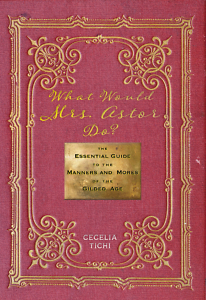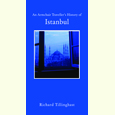How the Other Half Lived
Cecelia Tichi’s What Would Mrs. Astor Do? peeks into the lives of the Gilded Age rich
What Would Mrs. Astor Do? The Essential Guide to the Manners and Mores of the Gilded Age, the new nonfiction book by Cecelia Tichi, is tailor-made for fans of Edith Wharton: Tichi provides a complete and entertaining look at “the 400,” as high-society families in New York City were known during the nineteenth century. But general readers who enjoy an inside look at the lifestyles of the rich and famous will also find this book an entertaining read.
 In 1899, Harry Lehr introduced his fiancée, a young widow, to the society elites of New York. Mrs. Astor and her set were delighted that their friend had found a young woman to love. They gave her their stamp of approval, and the couple wed in 1901. It was a tale right out of a romance novel, except for one thing: on their wedding night, Harry told his bride, “There is no romance, and never can be any between us. Do not come near me except when we are in public.” In truth, he said, he found her “repulsive.” It was the young widow’s money he loved—it allowed him to maintain his friendship with that elite group.
In 1899, Harry Lehr introduced his fiancée, a young widow, to the society elites of New York. Mrs. Astor and her set were delighted that their friend had found a young woman to love. They gave her their stamp of approval, and the couple wed in 1901. It was a tale right out of a romance novel, except for one thing: on their wedding night, Harry told his bride, “There is no romance, and never can be any between us. Do not come near me except when we are in public.” In truth, he said, he found her “repulsive.” It was the young widow’s money he loved—it allowed him to maintain his friendship with that elite group.
Lehr, in a way, is characteristic of the age itself. Despite his perfidy, his outward show of affection for his wife meant that he was always welcome in the top tiers of society, where appearances often counted for more than reality.
Tichi throws open the curtains and doors on every aspect of the lives of the Gilded Age rich, allowing readers to see the rigid strictures that kept New York society life in line, and the rise of new money that made such strictures seem important. At the center of it all was Caroline Astor, the very definition of old money. An invitation to her annual ball could make or break a family’s role in that society. But Mrs. Astor was not above the hypocrisy that made such a system work: she never once set foot on her husband’s yachts, the places where he met his mistresses. She was prone to seasickness, she claimed. What she did not see, she did not have to worry about.
 Tichi, the William R. Kenan Jr. Professor of English and American Studies at Vanderbilt University, has done the sort of research one would expect from a renowned scholar. What Would Mrs. Astor Do? is documented with memoirs such as Mrs. Lehr’s, novels like Edith Wharton’s The House of Mirth, and newspaper articles.
Tichi, the William R. Kenan Jr. Professor of English and American Studies at Vanderbilt University, has done the sort of research one would expect from a renowned scholar. What Would Mrs. Astor Do? is documented with memoirs such as Mrs. Lehr’s, novels like Edith Wharton’s The House of Mirth, and newspaper articles.
But while this book is a complete study of the period, from what people wore to how they were buried, it is no dry tome. Instead, it’s a behind-the-scenes look at the celebrities of the day. (Times have clearly changed: many of today’s celebrities would never get an invitation to Mrs. Astor’s ball.) There are illustrations throughout of the people being discussed, as well as pictures of their houses, their clothes, and their carriages and cars.
Most people who dreamed of entering that elite club never did. Nevertheless, it takes only one Cinderella story to keep the dream alive, and Tichi provides one: One day, Mary Lily Kenan woke up a seamstress and went to bed the fiancée of a millionaire, a sad widower who needed a button sewn on his coat during a visit to Kenan’s employer. And Tichi doesn’t let readers forget those who kept the wealthy afloat: the servants who cleaned and cooked for them, the people who worked in their sweatshops, even the poor who were displaced when Central Park was formed.
What would Mrs. Astor Do is an entertaining book for readers who love history and Edith Wharton novels. It’s also for readers who want to see just how different the very rich are from you and me.

Faye Jones, dean of learning resources at Nashville State Community College, writes the Jolly Librarian blog for the college’s Mayfield Library. She earned her doctorate in nineteenth-century literature at Indiana University of Pennsylvania.


